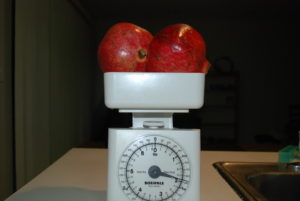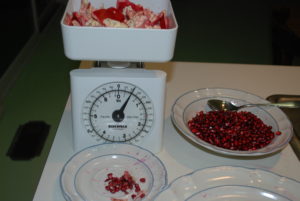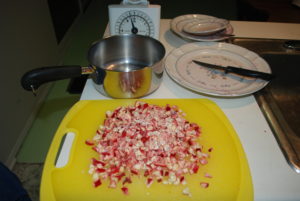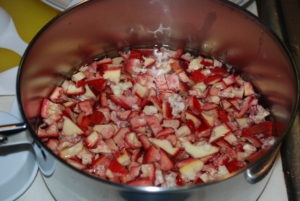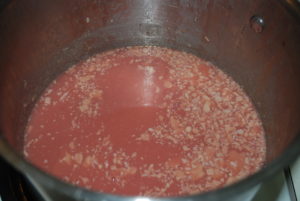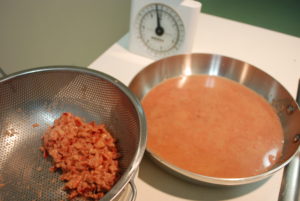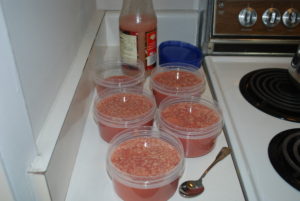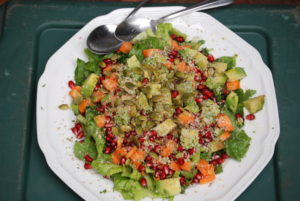The punchline – phospholipids are the building block of cannabinoids which are also a phytonutrient that causes an increase in production of Nrf2. (1, 3) The most concentrated source of cannabinoids or phospholipids is found in medical marijuana or the non-euphoric CBD oil which is more likely to be available legally. However there are other legal sources of phospholipids and cannabinoids. The phytonutrients are also found in cocoa beans/baking cocoa/dark chocolate (processing reduces the concentration and availability of the ‘bitter’ tasting nutrients in more processed milk chocolate and chocolate syrup.) Phospholipids add a slight bitter taste to foods which I’ve always been able to taste and tend to prefer. A genetic screening did find that I have a double/ both sets of genes/ difference in my ability to make any chemical with phosphorus – the phospho- part of phospholipids which are important in many chemicals in the body not just cannabinoids. (4 – an open access textbook on phosphorylation)
For example the original Lemonhead TM candies have more flavor to me than the more recent version of lemon flavored Chewy Lemonhead, (lemonhead.com). Bitterness is something we have a specialized set of tastebuds to detect. Our tastebuds have a few specific types and there are some that detect sweet, salty, sour, bitter, and some for Umami (fermented protein/free amino acid/a hint of soy sauce like flavor). Recently reseachers have suggested a set detect starch but sweet is also a starch so it might be similar to the sweet detecting tastebuds. The article explains that the difference between simple sugars and complex, longer chain carbohydrates called polysaccharides, can be detected suggesting there are two types of carbohydrate sensing tastebuds. (2)
Our sense of smell adds a lot more differences to our enjoyment of foods and beverages. Terpenes are particularly good smelling and other phenolic compounds also add aroma. Cinnamon and vanilla, basil, oregano and lemon are all sources of phenolic compounds or terpenes. These were discussed in more detail in the recent post on Nrf2 and diet tips for promoting Nrf2. It is a protein that causes genes that make important antioxidants to become active so it helps protect us against damage from oxidative stress which can be caused by health factors or by real world worries whether an upsetting conversation or bad traffic.
Pomegranate seeds (not the juice) and pumpkin seed kernels are also good sources of phospholipids. The spice cardamom powder is also a good source. See the section The DASH Diet and Pumpkin Seeds on the home page of my other website: effectivecare.info. A salad recipe and more information about genetics and cannabinoids are also available on that site or in the post Is it Starvation or Addiction?
Pomegranate extract has been studied in animal based research to examine in more detail how it helps hypertensive blood pressure problems and reduce oxidative stress. The mechanism was found to involve increasing Nrf2. The formation of mitochondria increased, and their function improved. Before treatment the hypertensive animals had fewer of the specialized proteins that are involved in production of mitochondria. Mitochondria are the cellular organelles primarily responsible for turning blood sugar/glucose into usable energy. (5)
This study uses a pomegranate extract that incorporates the peel, seeds and juice as all contain the bioactive phytonutrient, punicalagin, thought to be most helpful for anti-inflammatory, anti-tumor and anti-diabetic effects. The animals who received the extract were found to have better blood pressure, reduced heart hypertrophy ( a sign of worse heart health) and a lower heart rate. Neuronal/nerve cell activity and oxidative stress markers were decreased in the experimental treatment group compared to the control group which received a saline solution and no pomegranate extract. Angiotensin converting enzyme which is involved in blood pressure control was lower in the experimental group that received pomegranate extract and may be the mechanism for the lower blood pressure. Pro-inflammatory cytokines were reduced in the experimental group after treatment, an indication that hypertensive inflammation was reduced. The pomegranate extract treatment led to increased levels of phosphorylated AMPK which then leads to an increase in Nrf2 and its resulting increases in antioxidant proteins which protect against injury and inflammation from oxidative stress chemicals. (5)
Pomegranate is referred to as an ancient fruit in a research study on its benefits against hepatocellular carcinoma. Spoiler alert – it was found beneficial. (6)
“PE (Pomegranate Extract) treatment (1 or 10 g/kg), started 4 weeks prior to the DENA challenge and continued for 18 weeks thereafter, showed striking chemopreventive activity demonstrated by reduced incidence, number, multiplicity, size and volume of hepatic nodules, precursors of HCC (Hepatocellular Carcinoma).” (6)
One to ten grams per kilogram (1 to 10 g/kg) (6) gives us a quantity but that is of the extract which is made with the juice, seeds and peel. The inner peel is whitish in color while the outer peel is vibrantly colored similarly to the juice. An average adult weighs somewhere around 70 kg (68 kg ~ 150 pounds) so the animal study used an equivalent of 70 to 700 grams of pomegranate extract. Five grams is about a teaspoon so 70 grams would be slightly less than 5 Tablespoons or about 1/4-1/3 cup which is roughly a half a pomegranate worth of seeds with the juice and would be a reasonable serving size. Ten times that would be more than a typical serving at approximately two and a half to three and a third cups of pomegranate extract per day, for 22 weeks (6) – but if you have Hepatocellular Carcinoma that might sound good compared to other chemotherapy treatments.
My health and anxiety seems to be improved with a half a pomegranate worth of the seeds per day, or half in the morning and half in the evening when anxiety is worse. I have not tried using any part of the peel or interior whitish colored membranes so I don’t know what how edible they would taste. Pumpkin seed kernels are a higher fat food and the serving size is about 2 to 4 tablespoons, 1/8 to 1/4 cup as a snack my themselves or sprinkled on a salad. I prefer to have some of both foods every day. As well as other dark green leafy vegetables and herbs, beans, rice, nuts and other seeds, and ground lemon powder and/or lime or lemon juice. One healthy food alone isn’t enough to improve my health and mood on it’s own however the half a pomegranate can improve my mood when I’m having a worse anxiety moment. Pumpkin seed kernels are a higher fat and protein substance and don’t seem to have the quick acting mood lifting effect but I notice when I run out of them and don’t have any for a few days.
Regarding the “ancient fruit” reference in (6), yes pomegranate is mentioned in the Bible, Old Testament; 1 Samuel 14.2, “Saul was staying in the outskirts of Gibeah under the pomegranate tree…” and Old Testament; Haggai 2.19: “Is the seed yet in the barn? Do the vine, the fig tree, the pomegranate, and the olive tree still yield nothing? From this day on I will bless you.” Also pomegranates are mentioned as a decorative feature in a church: “House of the Lord” Jeremiah 52.17, 52.20-23 “As for the two pillars, the one sea, the twelve bronze bulls which were under the sea, and the stands, which Solomon the king had made for the House of the Lord, the bronze of all these things wre beyond weight. 21 As for the pillars, the height of the one pillar was eighteen cubits, its circumference was twelve cubits, and its thickness was four fingers and it was hollow. 22 Upon it was a capital of bronze; the height of the one capital was five cubits; a network and pomegranates, all of bronze, were upon the capital round about. And the second pillar had the like, with pomegranates. 23 There were ninety-six pomegranates on the sides; all the pomegranates were a hundred upon the network round about.” (7) So it seems pomegranates were thought quite valuable during Biblical times.
Menu tips to be continued later, Happy holidays!
Disclaimer: Opinions are my own and the information is provided for educational purposes within the guidelines of fair use. While I am a Registered Dietitian this information is not intended to provide individual health guidance. Please see a health professional for individual health care purposes.
- Li X., Han D., Tian Z., Gao B., Fan M., Li C., Li X., Wang Y., Ma S., Cao F.,
Activation of Cannabinoid Receptor Type II by AM1241 Ameliorates Myocardial Fibrosis via Nrf2-Mediated Inhibition of TGF-β1/Smad3 Pathway in Myocardial Infarction Mice., Cell Physiol Biochem 2016;39:1521-1536, https://www.karger.com/Article/FullText/447855 (1)
- Chase Purdy, The human tongue has a sixth sense and its a taste bud that loves carbs. Quartz, qz.com, Sept. 8, 2016, https://qz.com/776857/the-human-tongue-has-a-sixth-sense-and-its-a-taste-bud-that-loves-carbs/ (2)
- Wang Y, Ma S, Wang Q, Hu W, Wang D, Li X, Su T, Qin X, Zhang X, Ma K, Chen J, Xiong L, Cao F: Effects of cannabinoid receptor type 2 on endogenous myocardial regeneration by activating cardiac progenitor cells in mouse infarcted heart. Sci China Life sci 2014;57:201-208. https://www.ncbi.nlm.nih.gov/pubmed/24430557 (3)
- Claude Prigent, Editor, Protein Phosphorylation, Publisher: InTech, Chapters published November 29, 2017 under CC BY 3.0 license InTechOpen.com, https://www.intechopen.com/books/protein-phosphorylation (4)
- Wenyan Sun, Chunhong Yan, Bess Frost, Xin Wang, Chen Hou, Mengqi Zeng, Hongli Gao, Yuming Kang,and Jiankang Liu,
Pomegranate extract decreases oxidative stress and alleviates mitochondrial impairment by activating AMPK-Nrf2 in hypothalamic paraventricular nucleus of spontaneously hypertensive rats., Sci Rep. 2016; 6: 34246. https://www.ncbi.nlm.nih.gov/pmc/articles/PMC5054377/ (5)
- Anupam Bishayee, Deepak Bhatia, Roslin J. Thoppil, Altaf S. Darvesh, Eviatar Nevo, and Ephraim P. Lansky., Pomegranate-mediated chemoprevention of experimental hepatocarcinogenesis involves Nrf2-regulated antioxidant mechanisms., Carcinogenesis. 2011 Jun; 32(6): 888–896. https://www.ncbi.nlm.nih.gov/pmc/articles/PMC3314278/ (6)
- Holy Bible, Revised Standard Version, Containing the Ole and New Testaments, Thomas Nelson & Sons, New York, 1952, 1 Samuel 14.2, page 297, Haggai 2.19, page 984 https://www.amazon.com/1952-Revised-Standard-Version-Bible/dp/B000U2L3E0 (7)

